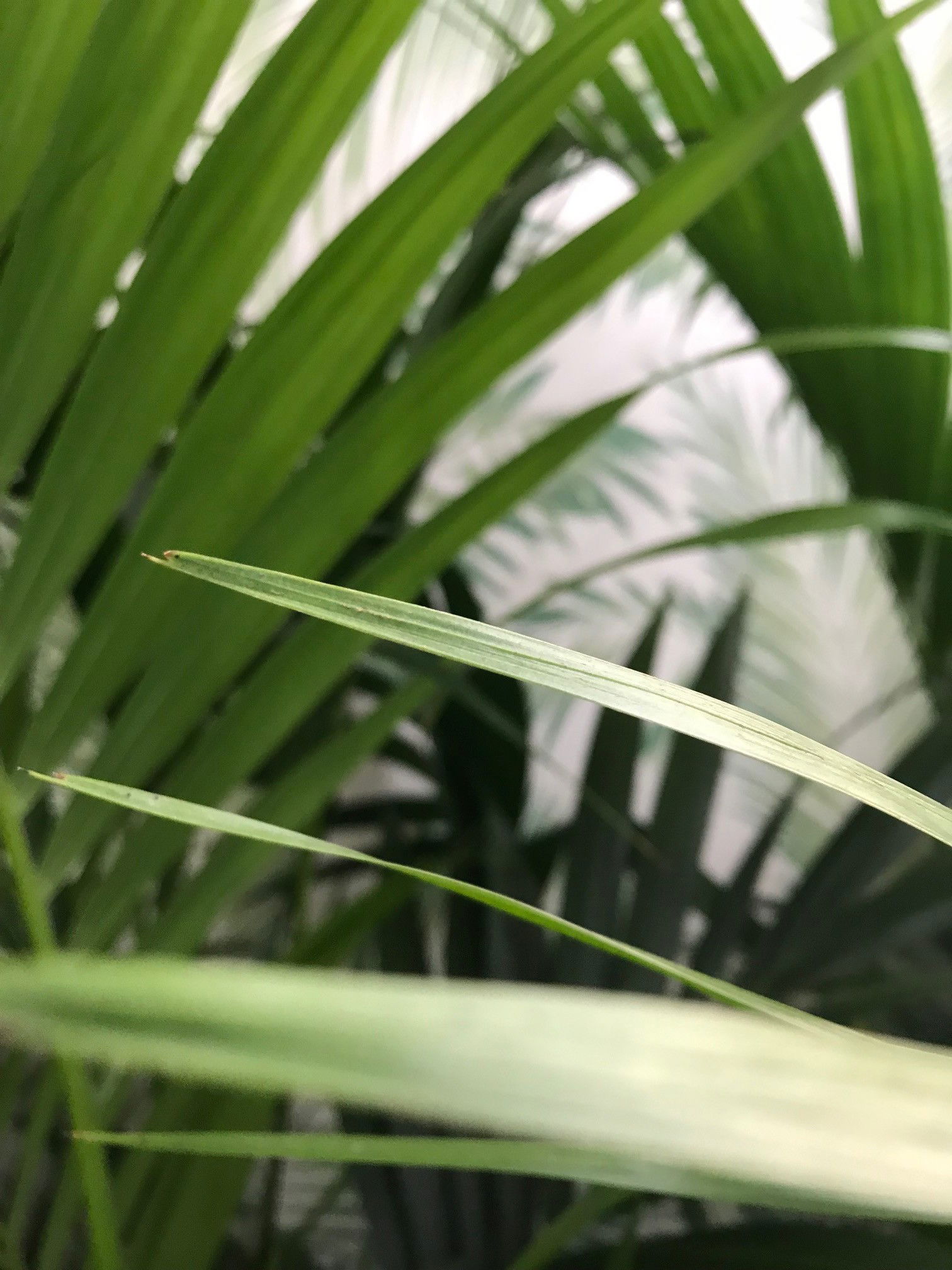
Howea forsteriana
Contents
- Top Tips
- Location, Water, Humidity & Fertilisation
- Common Issues
- Origins, Temperature, Propagation, Repotting & Toxicity.
Need the answer to a specific plant query? Book a 1-to-1 video call with THE HOUSEPLANT DOCTOR™, the website's friendly author, to overcome and address your niggling problem! Available on iMessage, WhatsApp, Facebook Messenger & more.
Top Tips & Info
- Care Difficulty - Easy to Moderate
- Although this article is aimed for the cultivation of Kentia & Sentry Palms, the two will be mentioned under 'Kentia Palms' throughout the document to save confusion.
- Bright, indirect light with little to no direct sunlight is best. Despite the idea of Kentia Palms thriving in dark locations, ukhouseplants would go against situating one in poor lighting due to the potential weakened health.
- Allow the top third of the soil to dry out in between waters. It's recommended not to use the bottom-up method of submersion due to the risk of root rot.
- Provide a humid location away from operating radiators by introducing a pebble tray over the colder months of the year.
- Fertilise using a 'Houseplant' or 'Palm' labelled feed every four waters in the spring and summer, reducing this to every six in the colder months.
- Repot every three years using a 'Houseplant' potting mix. Be sure to respect the roots as transplant shock is a big issue that could cause death in some cases.
- Keep an eye out for Spider Mites that'll locate themselves in webs along the ridges of the under-leafs.
Location & Light - 🔸🔸
Most positions around the house are tolerated, as long as they don't receive strong sunlight throughout the day. If your palm displays a 'washed out' appearance from sun scorch, it's most likely to do with a mixture of too much sunlight and not enough water. Although dark locations seem to be recommended for Kentias, avoid placing one in a location where a newspaper cannot be read without the use of lighting. Along with the heightened chance of over-watering, the plant's growth and production of photosynthesis will be hinder greatly, leading to an unhappy specimen.
A few metres within a north, east or west-facing window is best, or at least two metres away from a south-facing window. Again, low light levels are acceptable, but the chance of an unhappy palm is very high. Never situate a palm within a few metres of an operating radiator.
Water - 🔸🔸
Allow around the top third of the soil dry out the spring and summer, reducing this slightly further in the cooler months. It's important to use lukewarm water due to the root's sensitivity to cold temperatures - if it's too cold for teeth, it'll too cold for the palm, too! Kentia Palms cannot tolerate long periods of droughts, with under-watering and dehydration symptoms including yellow or paled fronds, little to no growth, brown crispy new growth and gradual decline. These issues are commonly caused by forgetfulness, being potbound or situated in too much light/heat. If it's placed in a bright location with a splash of sun, be sure to keep the soil adequately moist as prolonged dehydration can hinder new growth for several years. Alternatively, over-watering symptoms include a rotting stem, little to no growth and yellowing leaves; these issues are usually due to a lack of heat or sunlight, over-potted roots, an incorrect soil type or water-logging.
Humidity - 🔸🔸🔸
Palms love humidity, so creating a pebble tray is the best way to improve the surrounding growing conditions. While the radiators are operating, mist both sides of leaves frequently to combat the dry air, which can cause browning of leaf-edges and weak growth.
Fertilisation - 🔸🔸
Feed every four waters during the growing period and every six in the autumn and winter, using a 'Houseplant' or 'Palm' labelled fertiliser. Never apply a 'ready to use’ product into the soil without a pre-water first, as it may burn the roots and lead to yellowed leaves.
Common Issues with Palms
Root rot is a common issue with specimens sat in too moist or waterlogged soil for long periods. Symptoms include rapidly yellowing leaves, stunted growth and a rotten brown base. Take the plant out of the pot and inspect health below the soil line. If the roots sport a yellow tinge, you're good to go, but if they're brown and mushy, action must be taken immediately. More information about addressing root rot can be found on this link.
Yellowing lower leaves (closest to soil) could be a sign of over-watering, but equally is a byproduct of maturity. If the older leaves rapidly become yellow in quick succession, over-watering could be to blame. People don't realise that a plant's root system needs access to oxygen too; when soil is watered, the air will travel upwards and out of the potting mix. A lack of accessible oxygen for the roots will cause them to subsequently breakdown over the oncoming days. Click on this link to learn more about root rot and how to address it.
 These brown markings are entirely natural for Kentia Palms, so don't worry!
These brown markings are entirely natural for Kentia Palms, so don't worry!
Pests could arise at any time, with infestations starting from the original nursery or via contamination in your home. In most cases, pest infestations will be most visible on the oldest leaves. Spider Mites and Mealybugs tend to be the usual inhabitants, with the first being minute and almost transparent, roaming the leaves in search of chlorophyll and a site to hide its eggs. The latter, however, will stand out much more, with white cottony webs developing across the foliage and stems. Thoroughly check the plant's cubbyholes before giving it the all-clear, or click on the appropriate links to learn more about eradicating these issues.
Too low humidity can cause browning leaf tips with yellow halos. Although this won't kill your specimen, you may want to increase the local moisture to prevent the new growth from adopting these symptoms. Mist or rinse the foliage from time to time and create a humidity tray whilst the heaters are active to create a stable environment for your specimen.
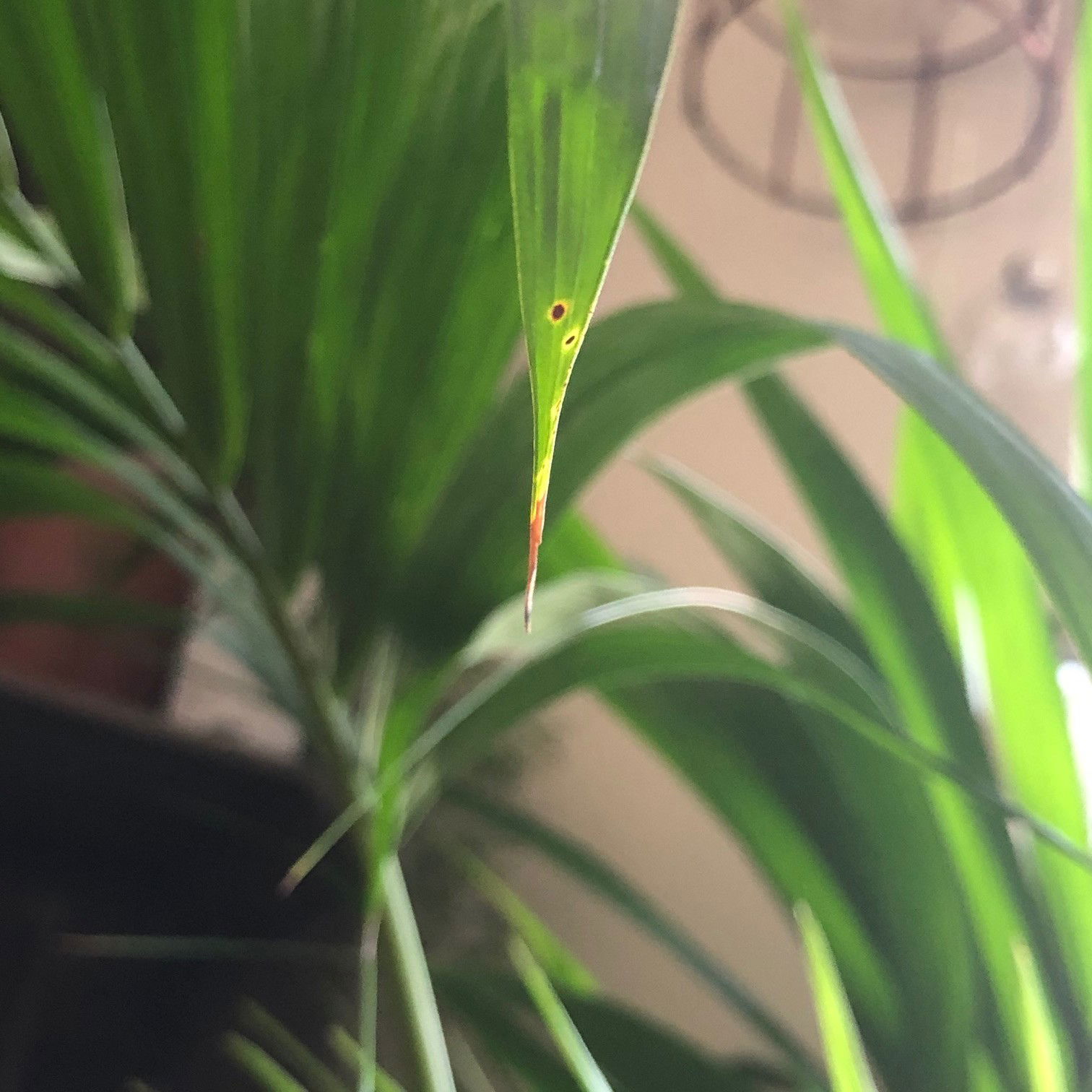 Browning crispy tips could be the product of loo low humidity or just leaf-maturity (old-age).
Browning crispy tips could be the product of loo low humidity or just leaf-maturity (old-age).
Transplant shock is a big issue when it comes to heavy-handed repots. Give the plant a good soak 24hrs before the action and never tinker with the roots, unless it has been affected by root rot. Typical signs of transplant shock are largely similar to under-watering, with wilting, yellowing leaves and stunted growth among the most common symptoms. Click here to learn more about addressing transplant shock, and a step-by-step guide on performing the perfect transplant.
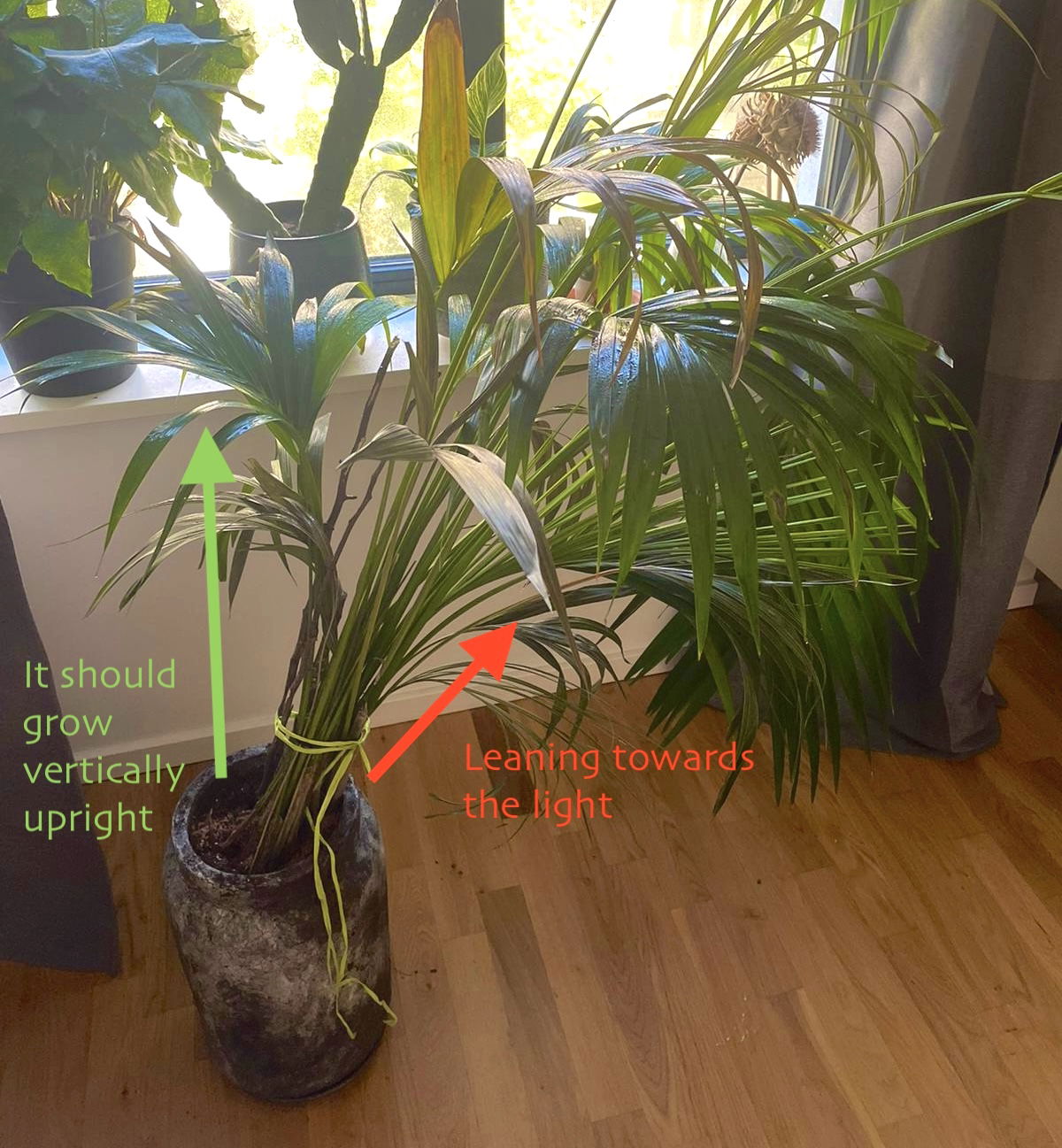 If your Kentia Palm is leaning to the side, chances are it's doing so to capture the light. It'll do best within 2m of a windowsill or in a semi-heated conservatory where the near-overhead natural lighting will produce quicker, more reliable growth.
If your Kentia Palm is leaning to the side, chances are it's doing so to capture the light. It'll do best within 2m of a windowsill or in a semi-heated conservatory where the near-overhead natural lighting will produce quicker, more reliable growth.
There are several species of Leaf-Spot Disease, (Graphiola, Botrytis, Anthracnose & Cercospora) and all of them operate in the same way. Fungi spores will land on the leaf's surface and will slowly develop along with the plant. Unfortunately, as there aren't any products that'll address the issue head-on, you can only remove the affected areas and regularly wash the leaves to limit the spread. Keep the plant away from unaffected specimens for at least a month after the last symptom.
Mould developing on the soil means two things - too little light and periods of overly moist soil. Despite the harmlessness of the mould, it'll prove unsightly to most gardeners and is often removed. To remove, replace the top two inches of the soil for a fresh batch of 'Houseplant' compost, preferably coconut-coir based soil. Either increase the amount of light received (no direct sunlight for the first few weeks to prevent environmental shock) or decrease the frequency of waters slightly. If the mould is accompanied by yellowing lower leaves, you may also have a case of root rot.
Origins
Howea consists of two species that are endemic to Lord Howe Island, just off the Australian east coast. The species, H. forsteriana, is named after the father-son duo of Johann & Georg Forster who accompanied Captain Cook's second voyage to the Pacific Ocean in the 1770s. The trip proved successful in terms of classifying several new species in the New World, which includes the popular Norfolk Island Pine. By the 1880s, the species received great popularity across England, with Queen Victoria ordering the palms to be in each of her residential homes. By the time of her death in 1901, she had ordered the palms to circle her coffin why she lay in rest. The association of the species with royalty and prestige continued through to the Edwardian period too; the Titanic's first-class Verandah Café had several specimens around the establishment, as well as in lobbies and hallways of the main boat. Although the Sentry Palm (H. belmoreana) is of close relation to the Kentia, its curling fronds and slower growing nature is easily distinctive when the two are placed next to each other.
Howea forsteriana had a significant role in the island's trade and economic development during the late 19th century onwards, much larger than the tourism trade at the time.
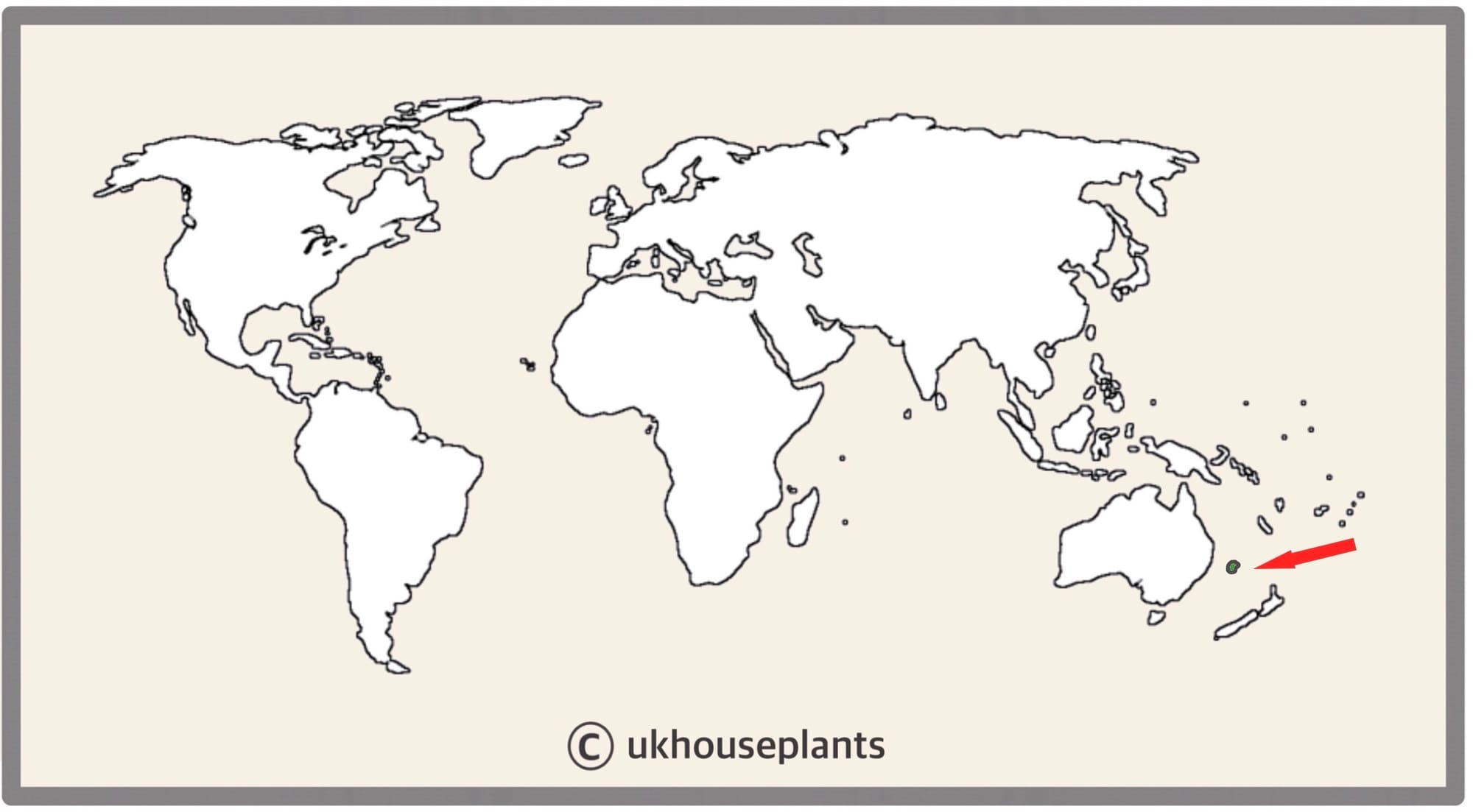 The Distribution of the Kentia & Sentry Palms.
The Distribution of the Kentia & Sentry Palms.
Temperature
13° - 30°C (55° - 86°F)
H1b (Hardiness Zone 12) - Can be grown outdoors during the summer in a sheltered location with temperatures above 12℃ (54℉), but is fine to remain indoors, too. If you decide to bring this plant outdoors (highly recommended if it's unwell), don't allow it to endure more than an hour of direct sunlight a day as it may result in sun-scorch and dehydration. Regularly keep an eye out for pests, especially when re-introducing it back indoors.
Spread
Up to 4m in height and 1.5m in width. The ultimate height will take between 5 - 10 years to achieve, with two new fronds put out each year.
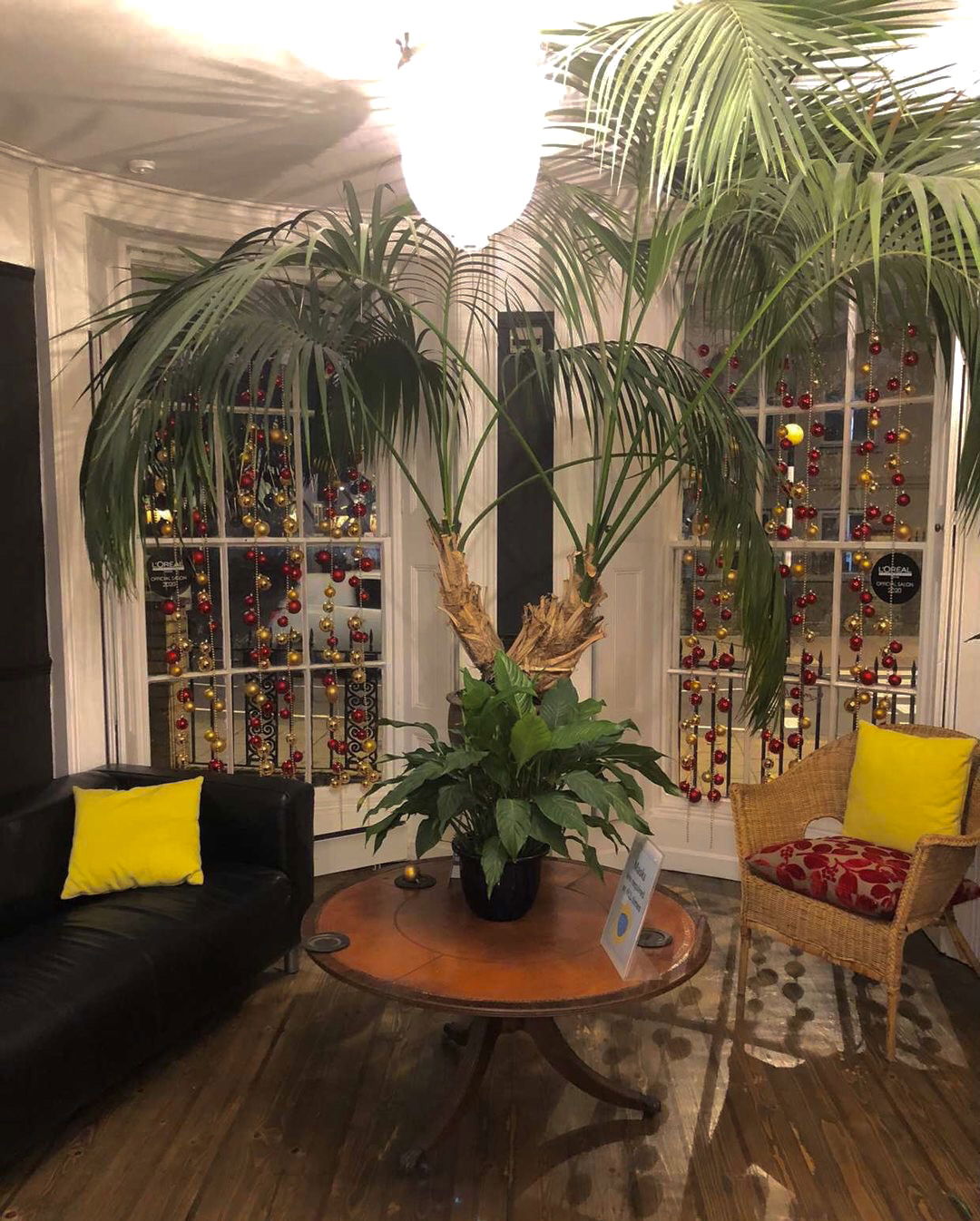 If you have good houseplant skills, your Kentia Palm will eventually reach this size within around 25 years! Credit: THE END Salon.
If you have good houseplant skills, your Kentia Palm will eventually reach this size within around 25 years! Credit: THE END Salon.
Pruning & Maintenance
Remove yellow or dying leaves, and plant debris to encourage better-growing conditions. While pruning, always use clean scissors or shears to reduce the chance of bacterial and fungal diseases. Never cut through yellowed tissue as this may cause further damage in the likes of diseases or bacterial infections. Remember to make clean incisions as too-damaged wounds may shock the plant, causing weakened growth and a decline in health.
Propagation
Via Seed Propagation.
Seeds (Easy to Moderate) - Soak the seeds in lukewarm water for around 24hrs in a dark location, preferably on top of an operating radiator. The best soil to use is a 'Houseplant' labelled potting mix, however, 'Multipurpose' compost with added perlite and sand is just as good. Set the seeds around an inch into the potting mix, resisting the temptation to compact the soil. Maintain evenly moist soil and allow the excess water to freely drain from the pot's base to prevent water-logged conditions. The ideal location for successful germination is in a bright, indirect setting with temperatures above 18℃ (64℉) with bottom-heat. Keep the pot in a transparent bag to provide a stable level of humidity, along with longer lasting soil moisture. Germination may take up to a six months, so don't discard any unsuccessful seeds until this threshold has been surpassed. Remove the bag once the seedlings produces its second leaf. Remove the bag once the seedlings produces its second leaf and then split them up into their own 3cm pots.
Flowers
They'll produce white feather-like panicles of flowers during spring or summer once maturity is reached. Although the sowing of palm seeds is relatively easy, artificial pollination is rather difficult without specific training. The blooming period lasts up to several weeks with the seedpods taking up to two three to fully develop. The seedpod will begin life in a green tone before transitioning into yellow, and then red during its stages of maturity.
Repotting
Repot every three years in the spring, using a 'Houseplant' labelled and the next sized pot with adequate drainage. Hydrate the plant 24hrs before tinkering with the roots to prevent the risk of transplant shock. For those that are situated in a darker location, add an extra portion of perlite to the potting mix to improve drainage and downplay over-watering. Click here for a detailed step-by-step guide on transplantation, or via this link to learn about repotting with root rot.
Pests & Diseases
Keep an eye out for mealybugs, spider mites, scale & thrips that'll locate themselves in the cubbyholes and undersides of the leaves. Common diseases associated with Kentia Palms are root rot, leaf-spot disease, botrytis, powdery mildew & southern blight - click here to learn more about these issues.
Toxicity
Not known to be poisonous by consumption of pets and humans. If high quantities are eaten, it may result in vomiting, nausea and a loss of appetite.
Retail Locations
Homebase, B&Q, IKEA, Dobbies, Blue Diamond, Online Stores.
Book a 1-to-1 Call with THE HOUSEPLANT DOCTOR™
If you need further advice with your houseplants, book an advice call with ukhouseplants' friendly and expert writer today! This can be done via a video or audio call on most apps, including Facebook, FaceTime & Skype. A ten-minute call costs £5.99 (US$7), or £15.99 for thirty minutes. You can ask multiple questions, including queries on plants, pests, terrariums, repotting advice and anything in between. Please consider supporting this service to keep ukhouseplants thriving!